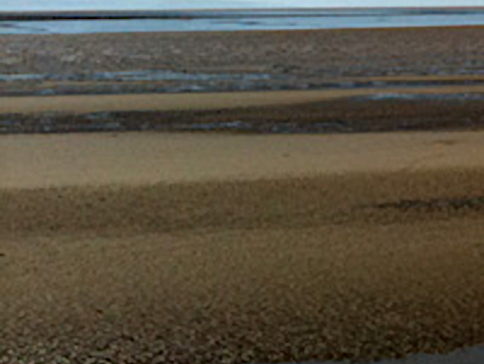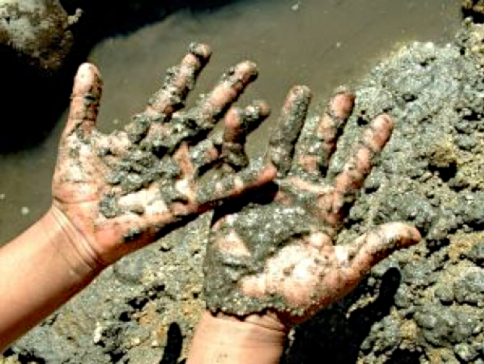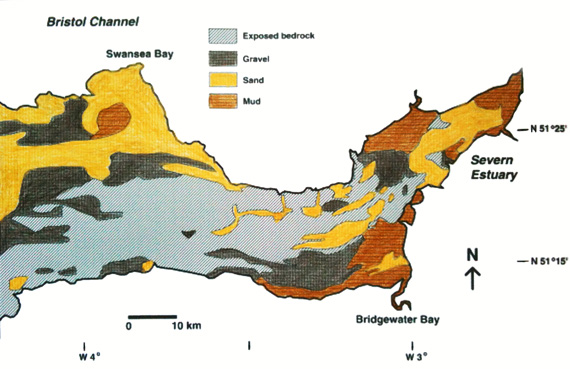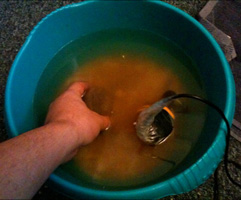Environmental Sound, Sonic Art, Physical Computing, Performance
Sedimentsonority

Sediment leaving the Severn Estuary, copyright © 2008-2012 Chelys srl
Sedimentsonority was pilot study to model some of the sediment movements in the Severn Estuary, UK, using sound.
Finding were presented at Land Water : Image Conference, Plymouth, 2012, and the RGS-IBG Annual International Conference Exeter 2015: Palmer, M. & Jones, O. (2015). Further towards sonifications of elemental ecological systems/relationships: Salt marsh ecology experiments in temporal immersion and exchange; RGS-IBG Annual International Conference Exeter 2015
Sound is a medium we readily immerse ourselves in. Although the movements of estuary muds could be easily visualized (see map above), this process removes the viewer from the object it aims to explore. Indeed, many art projects about water place the viewer/listener outside of it. An immersive viewpoint is valuable, as it allows us to re-experience a place with our senses.



Translating the tidal mix of salt and freshwater, dispensed solids and biomatter into sound is truly fascinating, as here processes of self-organization become audible. Discovering and reflecting on this can reveal deepen our understanding of water processes, or of how the world around us organizes itself. Exploring sediment characteristics via sound can lead to a deeper understanding of tidal landscapes and the complex processes they adhere to.
Severn Estuary Sediment

Sediment distribution in the Severn Estuary
Places like the Severn estuary are the most productive ecosystems on the planet. For example, it is estimated that about 30,000 snails can be found within each m2 of mud. And the Severn Estuary contains about 100 km2 of intertidal mud flats.
Severn estuary mud originates from small rivers, like the river Parrett. It is a mixture of clay minerals, sands and polysaccharides (mucus produced by mud-dwelling microorganisms). The sands and the polysaccharides render the mud more cohesive and increase its ability to bind pollutants (heavy metals, pesticides, etc) present in the water.
During the incoming tide, much of the estuary mud re-suspends itself and forms large-scale mobile or static suspensions (slugs and pools), which then disappear again with the outgoing tides. This kind of dynamic self-organization has often been described in complexity theory, but in the estuary it can be readily observed.
Waves with fetches of up to 6000km extending into the Atlantic Ocean generate strong currents near the bed of the Severn estuary. These currents influence whether mud suspended in the estuary can settle or not: where the near bottom currents are strong, we find areas of exposed bedrock, where they are weaker we find gravel, sand or mud.
Other phenomena are its quicksand pools, often concealed within sand banks, that make walking at low tide quite tricky. The funnel shape of the estuary amplifies the incoming tides, sometimes creating a surge wave, the Severn Bore, which if the conditions are right can travel upstream unbroken for many kilometres.
During spring tides, the accelerated flow of water means that a larger amount of silt is re-suspended and moved about in the estuary. Then about 30 million tonnes of fine sediment are in suspension.
Tidal pumping, the increased transport of sediment towards the head of an estuary, occurs during spring tides. Tidal pumping and the tendency for sediment to settle during neap tides causes so-called estuary turbidity maximia (ETMs), which make it very difficult to predict where exactly sediments may go into (re)suspension, and where they may settle.
Researchers found that, despite their mobility, fine muddy sediments are being maintained in the estuary for 10 years or more. So only in certain tidal and weather conditions can waste released into the water actually leave the estuary.

Aerial view of the beach at Burnham-On-Sea
Concept
Field-recording of fine sediments is difficult, since the sounds are quasi-inaudible and easily overpowered by other environmental sounds. Using a hydrophone in shallow water, one might hear traffic sounds above water more readily than any sediment movements.
 Recording sediment movements in a tank also has its draw-backs, as it is quite likely to record the sediment scraping against the container and not the grains or flocs brushing against each other.
Recording sediment movements in a tank also has its draw-backs, as it is quite likely to record the sediment scraping against the container and not the grains or flocs brushing against each other.
Data sonification would be an alternative, however, data sets covering an area of sufficient space and time in the Severn Estuary are not readily available. Data from various studies would have to be pieced together, or new probes that allow for continuous measurements deployed.
This leaves sonic modelling. Since there are so many sediment phenomena (flocculation, forming of slugs, pools, funnel effect, tidal pumping, etc) it is useful to limit what is to be modelled, otherwise the listening experience can quickly become unclear. A useful starting point might be to focus on types of mud suspension:
- Mobile suspensions moving in the water with the tide. Similar viscosity to water. Small floc sizes. Depend on basination, tidal movements, and proximity to river mouths.
- Stationary suspensions are not moving horizontally with the tide, but gradually settle during slack water periods.
- Fluid muds have reached a ‘gelling point’ where the water between the mud particles has been expelled by gravity. More consistent in texture, but still mobile, and up to 5m thick (more in some places), making it difficult to navigate by boat.
One method of modelling a slug's movement within the estuary waters is by using 3D Boids, for example Eric Singer's 3D Boid external for Max/msp.
Boids were originally developed to simulate the flocking behaviour of larger objects such as birds or fish. For Sedimentsonority, each 3D boid represents not a single mud particle, but the centre point of a dispersed sub-swarm. Using a modelling program, it becomes possible to link spatial boid data to a surround sound field. This holds the key to creating an immersive listening experience.
Combining boids with granular synthesis provides a useful set of parameters to model self-forming and self-dispersing mud suspensions. The model not only allows for the computation of different environmental conditions, but can also be used to interpolate real data points. The emerging sounds can also be translated into a 3D audio file.